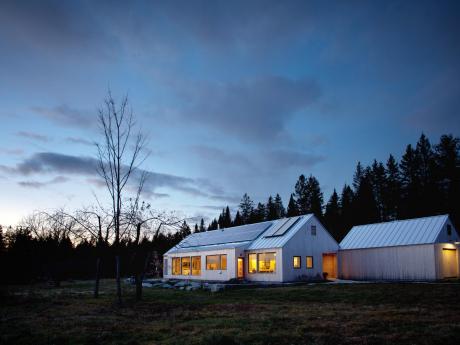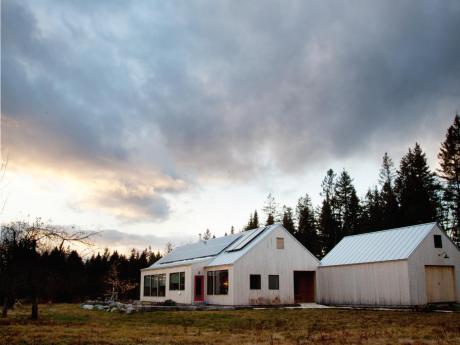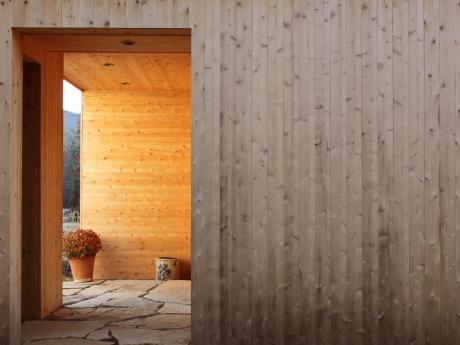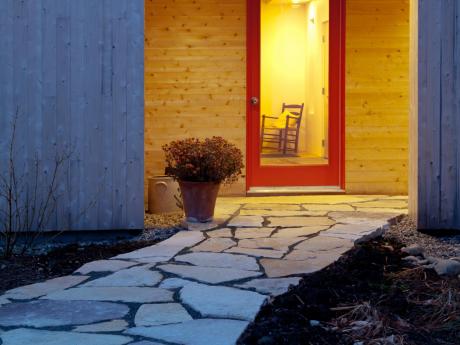Southworth Retirement Residence
Project Photo Gallery
Project Team
In 1986 my brother Harry and I started a building company, Garland Mill Timberframes, at our sawmill in Lancaster, NH.
Twenty years later, led by my son Ben, and with energy design help from Marc Rosenbaum, we began working with Jane Bindley to transform her lakeside home in Holderness into a net-zero residence. This remarkable woman was a delight to work with and the project was a success.
Janeʼs vision inspired us then and has continued to inspire our work to this day.
It was only a few years later that my wife, Nancy, and I started planning for a downsized retirement home to be built in a south facing field across the road from our mill. We agreed that if either of us lived to be ninety we ought to be in a home that one person could maintain alone.
The house was built to PassivHaus specs, again with help on the energy front from Marc Rosenbaum, and was completed in April of 2011. It is all one story with 1620 square feet of treated floor area.
Solar panels were added the next month. Their annual energy production exceeds the electric demand...and does so by a wide enough margin that if additional resistance heating replaced the woodstove there would still be a net excess. One very strong additional motive for installing 30 PV panels was to have electricity available to power an electric vehicle. So far, our two year average excess of 4,000 KWH would suffice to drive an EV about 10,000 miles, which it soon will do.
Nancy wanted a simple modern aesthetic. With Benʼs help this was achieved in a variety of ways. Materials were local, often salvage, always simple. White cedar cladding. Soapstone counters. White pine timbers from our mill. Beech floors. Plaster walls. Galvanized steel roof. Windows with plaster jam returns. For the big glass, maple sills were made from a blow-down at a local sugar orchard. Modern Danish wood stove.
Flooring installed to the plaster walls with no baseboard trim.
The completed project has satisfied all the points on our original wish list. As the home owner I can say that now, after all these years in the house, if we were to do it all over again we would build it just the same way.
Quick Facts
General
| Location | Lancaster, New Hampshire |
|---|---|
| Project Type | Zero Energy |
| Basis of Performance Claim | Modeled |
| Conditioned Floor Area | 1,986 sq ft |
| Total Cost of Project | $280,227 |
Energy Summary
| Energy Data Type | Modeled |
|---|---|
| Renewable Energy System Type(s) | |
| Ratings | |
| Annual renewable energy generated | 8,182 kWh/year |
Envelope and Mechanicals
| Subslab assembly |
Foundation - There is no slab. A hardwood floor is fastened directly on ¾” advantech which in turn is fasted to 2X4 sleepers over 12” of salvage polyisocyanurate foam insulation (R-55), above a vapor barrier and 30” of compacted sand. The four foot foundation frostwall is insulated from the inside with 3” of rigid insulation board (polyiso) that makes direct contact with the wall insulation (dense packed cellulose). There is neither basement nor crawl space. |
|---|---|
| Above grade wall assembly |
The bearing exterior wall is 2X4 construction covered (going outward) with 1/2” plywood then 2” of rigid polyiso foam insulation then tape and rain drain then horizontal strapping and finally 3/4” white cedar vertical siding. A second 2X2 wall was built 12” inside the building and gusseted to the 2x4 wall with ½” plywood gussets. It is nonbearing and rests on the subfloor (advantec) which was held back to allow the polyiso subfloor insulation to be in direct contact with the dense packed cellulose wall insulation that was blown in between the two walls. The wall R-factor is calculated at R-49 for 12” of cellulose plus 2” of polyiso. This effort was to assure continuous thermal isolation and is compromised only by the gussets and the window and door bucks. |
| Door Assembly |
ThermoTech Fiberglas Fenestrations |
| Air Changes per hour, ACH50 | 0.65 ACH50 |





